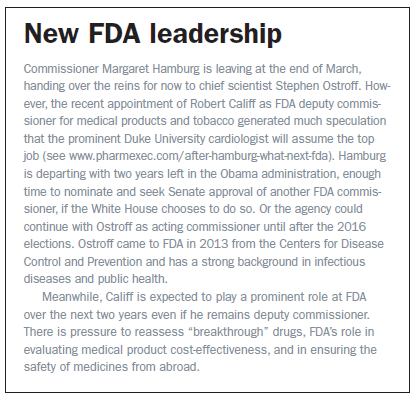Will FDA Fixes Spur Innovation?
Pharmaceutical Executive
Congress, Obama offer strategies to reduce regulatory roadblocks to new breakthroughs.
The productivity and efficiency of the US biomedical research enterprise is undergoing a broad reexamination, including how FDA regulation serves to bring-or block-new medicines from the market. The announcement of FDA Commissioner Margaret Hamburg's departure at the end of January further heightens the focus on recent agency accomplishments and options for change.

Jill Wechsler
'Precision' & 'Cures'
FDA's role in encouraging new medical technology appears in President Obama's "Precision Medicine Initiative," a $215 million program to create a massive database of patient genomic information to support future biomedical research. The proposal provides $130 million for the National Institutes of Health (NIH) to develop the data system, $70 million for the National Cancer Institute to identify genomic factors important for developing effective oncology treatments, and $10 million for FDA to devise new strategies for regulating next generation sequencing (NGS) technologies.
Despite its high-profile announcement, the White House plan faces serious hurdles. Linking together data on one million patients held in diverse systems is no easy task, particularly with the need to protect patient privacy while facilitating researcher access to the information. The administration's budget plan for 2016 highlights the "Precision" program, along with proposals to bolster research on new drugs to combat antibiotic resistance, and to modestly increase NIH and FDA funding.
The Obama plan comes on the heels of the "21st Century Cures Act," a massive document offered by House Energy & Commerce Committee chairman Fred Upton (R-Mich) designed to launch a broad discussion about multiple reform proposals. The package features numerous patent and exclusivity provisions that aim to encourage private sector investment in biomedical research activities, along with measures to streamline clinical trial operations, reform oversight of medical devices, and expand incentives for antibiotic development.

The "Cures" package also proposes to loosen controls on drug marketing. One measure would permit a "one-click" policy that simplifies how pharma companies can provide links to risk information when discussing approved products via Twitter, Facebook and other Internet platforms. And it alters the Sunshine Act so that journal articles and medical textbooks, as well as funding of independent continuing medical education, would not have to be reported as "gifts" to prescribers. Compassionate access to not-yet-approved therapies for severely ill patients gets a nod by requiring pharma companies to be more "transparent" about access programs and forming a new task force to recommend further access reforms.
The unveiling of Upton's 400-page "discussion draft" was muted, however, by an absence of the bipartisan support that has been important to building interest in this broad initiative, and by its failure to mention any funding strategies for its many programs. Rep. Frank Pallone (D-NJ) expressed disappointment with the plan, and "Cures" co-chair Diana DeGette (D-Colo.) withheld her endorsement. Health and biopharma organizations issued perfunctory statements supporting the effort, and DeGette left the door open for continuing negotiations to reach bipartisan consensus.
Senate weighs in
The House Cures proposal could gain from a related initiative by the Senate Health, Education, Labor and Pensions (HELP) Committee to examine FDA and NIH programs for speeding new treatments to patients. The effort began in January with HELP Committee chairman Lamar Alexander (R-Tenn.) and Sen. Richard Burr (R-NC) issuing a lengthy report on FDA regulatory inefficiencies that delay medical product development and on how NIH could improve its strategies for funding and conducting biomedical research. This report on "Innovation for Healthier Americans" describes a number of well-established collaborative strategies for overcoming R&D barriers, such as streamlining clinical trials, updating research standards, and making regulatory pathways more predictable.
Now the initiative is moving forward with bipartisan support from HELP Committee ranking Democrat Patty Murray (D-Wash), who joined in announcing a series of hearings on the HELP proposals beginning this month. But fast consensus on a few specific measures agreeable to both sides of the aisle is needed to enact any FDA reform bill this year. Leading Republicans and Democrats on the E&C panel have backed a measure to reduce delays blamed on the Drug Enforcement Agency in developing and approving drugs classified as controlled substances. That and other targeted policy changes, along with added antibiotic incentives, could form a narrow measure able to move through Congress quickly. Otherwise, there won't be any new FDA legislation until 2016, when Congress will face a deadline for authorizing the next round of FDA user fees. And that probably will be just fine with agency leaders.
FDA accomplishments
Many of the legislative proposals for improving the return on the federal government's investment in biomedical R&D are not new and already are being implemented by FDA. For example, the agency stole the thunder from the House compassionate access request by unveiling last month a shorter and simpler form for physicians to seek access to investigational drugs for individual patients. Compassionate use advocates still criticized the change as "window dressing," but the FDA guidance addresses charges of administrative overkill.

FDA also hopes to deflect difficult new requirements by touting recent accomplishments, as summarized by Hamburg in a posting last month. She highlights the agency's surge in new drug approvals and progress in curbing opioid abuse, encouraging new antibiotics, tackling unsafe pharmacy compounding, and facilitating development of new vaccines against Ebola and other infectious diseases. Initiatives to encourage development of "precision" medicine top the agency's agenda, as it continues to expand consideration of patient perspectives in testing and evaluating more targeted therapies for critical diseases.
FDA officials would like to do more to support development of biomarkers and innovative clinical research strategies, and additional resources would bolster such efforts. The Obama administration has proposed a small increase in FDA funding for 2016, but most new dollars for oversight of drugs and biologics comes from higher user fees. FDA officials have reason to be wary of new bills from Congress that require multiple new activities for ensuring the efficacy and safety of medical products-but not much money to finance those programs.
Jill Wechsler is Pharmaceutical Executive's Washington correspondent. She can be reached at jwechsler.advanstar.com.

Pfizer, GSK Gain ACIP Recommendations for RSV and Meningococcal Vaccines
April 18th 2025The Centers for Disease Control and Prevention’s Advisory Committee on Immunization Practices voted to expand access to Pfizer’s respiratory syncytial virus vaccine Abrysvo for high-risk adults in their 50s and voted in favor of GSK’s meningococcal vaccine, Penmenvy, for streamlined adolescent protection.
Navigating Distrust: Pharma in the Age of Social Media
February 18th 2025Ian Baer, Founder and CEO of Sooth, discusses how the growing distrust in social media will impact industry marketing strategies and the relationships between pharmaceutical companies and the patients they aim to serve. He also explains dark social, how to combat misinformation, closing the trust gap, and more.